Stinky shoes are the oft-dreaded sign of a foot fungus infection. For more extreme situations, your toenails can show the signs of the fungus by discoloring, becoming thick and crumbly, or pulling away from the nailbeds. Blisters, itching, cracking, peeling, and burning can plague your feet. This article will help aid you with how to remove fungus from shoes.
Tinea fungus is responsible for athlete’s foot and can be contracted through an infected person or by touching a surface that is contaminated. Fungus in shoes typically is caused due to trapped moisture. Dark, warm and moist environments are the perfect breeding ground for fungus, and shoes definitely fit the bill. The sweat and dirt found in shoes makes them an optimal growing condition for fungus.
Since killing shoe fungi and preventing it is nearly the same, it is important that while you treat your shoes, you focus on healing your feet simultaneously. Treating your foot and shoe at the same time is the best approach for not allowing the fungus to re-infect either the foot or the shoe.
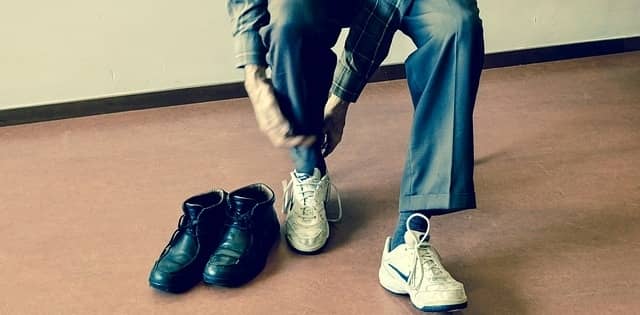
Multiple pairs of shoes and socks
If you are wearing shoes all day, it is a wise idea to have multiple pairs of shoes to swap out. Especially if you sweat or work in moisture-laden environments, two sets of the same shoe allows you to wear one pair while the other one airs out.
Socks worn multiple days in a row up the chances of fungus growth, not to mention building up the dirt in the shoe and foot. Dark socks allow the fungus to breed faster, as the signs of the fungus may be harder to spot. Adding to this, the darker socks allow your feet to accumulate heat faster, sweating more and creating excess moisture in the shoe.
Click here for an in depth article about moisture wicking socks
By wearing the same shoes and socks constantly, you are unable to remove the fungus. Each attempt you make will be lost to the further accumulation of moisture and heat. Switching out shoes and socks daily prevents the conditions from creating a fungus-playground.
Disinfectant foot spray
Disinfectants work by killing bacteria. Since fungi are a product of bacteria, disinfectants can be effective in killing them. When you purchase disinfectants for shoe fungus, some work double duty by also keeping foot perspiration at bay. Many are portable and multi-purposeful.
While bleach can disinfect, it can also ruin the shoe and the skin. With the prominence of multiple options, bleach is not necessary in using as a shoe disinfectant.
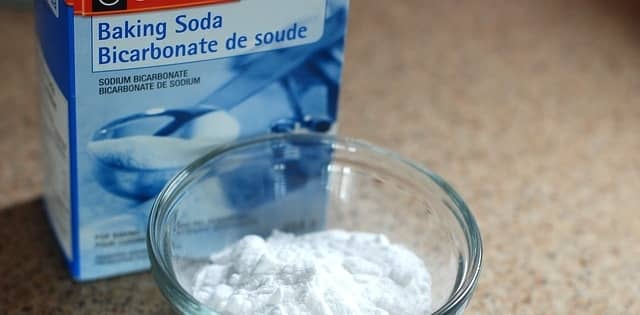
Vinegar and baking soda
Spraying shoes with vinegar or baking soda are two other methods to help combat shoe fungus. Apple cider vinegar can be substituted for regular vinegar if wanted. Don’t worry, when vinegar dries, the unmistakable odor also dissipates.
Vinegar, as an acid, lowers the pH of bacteria. When this happens, essentially, the motor of the bacteria slows and for some, eventually stop. Baking soda, on the other hand, seems to show some reactions of decreasing the number of viable cells. By using both, you stand a better chance at keeping the bacteria at bay.
The baking soda also works to help soak up some of the smells that are produced with fungus. Simply sprinkle the inside and out of the shoes. If you chose to use the vinegar, fill a spray bottle and spray the inside and outside each time you are not wearing the shoes.
Shoe sanitizers
A shoe sanitizer is a small machine that you insert into your shoe. The ultraviolet light that projects from the sanitizer kills bacteria, fungi, and microbes within 25 minutes. While sprays can help keep the fungus away, the sanitizer kills any bacteria that cannot yet be seen.
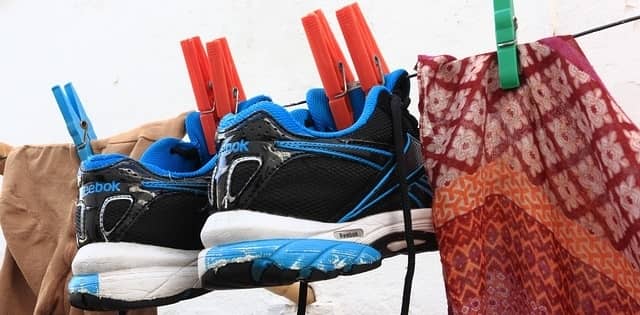
Sunlight
Since sunlight has UV light, drying your shoes in the sun is an effective method at killing the invasive shoe fungus. The sunlight fights against existing spores in the shoes.
By combining this method with anti-fungus spray or powder, you can utilize the sun to keep the fungus from spreading.
Disinfectant foot powder
Foot powder uses Miconazole powder which weakens the cell membranes of the fungi. When weakened, the fungi cannot effectively replicate. For best results, apply daily and ideally at night when the powder can work through the entire night.
Does bleach kill fungus spores?
According to an article found on the University of Florida Health’s page, in order for bleach to be effective in killing fungus spores, it must be diluted to a ratio of 1-part bleach to 10 parts water or 1 cup bleach to a gallon of water. The important part to note here is that if the bleach mixes with other materials or liquids, it can change the ratio of the bleach to water.
Since this is a high concentration of beach to water, pets should be removed from the area using the bleach. People should ensure they use protective equipment when handling the bleach solution and wash their skin right away if it were to get on them.
How long does toenail fungus live on surfaces?
It is not known exactly how long toenail fungus can live. That said, fungus in itself can live on surfaces for up to six months. The belief is that the spores causing toenail fungus would follow the same pattern.
Because some people show no initial signs of a toenail fungus infection, they may not even know their shoes are carrying the spores. You go to a friend’s house and borrow a pair of seemingly clean shoes and the next thing you know; you now have acquired a memorable case of toenail fungus. Not so much fun, nor a gift worth getting.
To keep yourself safe, do not wear borrowed shoes and regularly disinfect your own shoes. If you must wear shoes belonging to someone else, bring your own socks and wash your feet as soon as you can.
Does Lysol kill fungus in shoes?
Lysol is a disinfectant and can kill fungus in shoes. That said, this doesn’t mean it is the safest thing to use for killing fungus. Because Lysol contains some harmful ingredients such as ethyl alcohol and triethanolamine, it is not necessarily the first option we would suggest.
How long can toenail fungus live in shoes?
Fungus can live in shoes for 6 months to even years
in spore form. Fungus needs dark, warmth and moist environments to live and
grow. Shoes provide this and due to some shoe construction, often have places
to hide within the shoes. Make sure to thoroughly disinfect shoes before
packing them up for the following season of use or if you have received
hand-me-downs or second hand store finds.
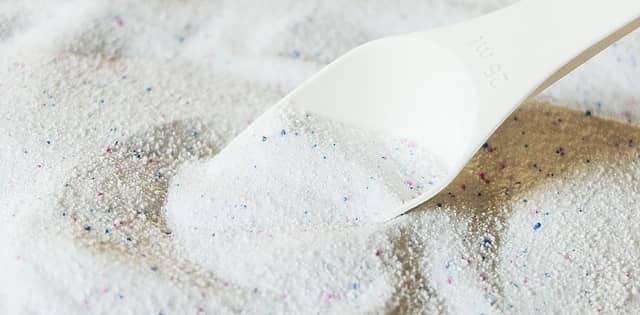
Best antifungal laundry detergent
Before looking at specific detergents, it is important to note the water must be ultra-hot. A study of water temperature’s effectiveness in killing fungus was conducted. Individuals with the fungi on their feet wore socks and then took them off for testing.
These socks revealed 85% of participants transferred the fungus to the socks. When they washed the socks, one set was washed at 104 degrees Fahrenheit and the second set was washed at 140 degrees Fahrenheit. 104 degrees Fahrenheit is your typical warm-wash setting and 140 degrees is the typical hot-water setting. Note: if your hot water temperature setting is turned down, this may not be the case for your washer.
The socks washed in 140 degrees Fahrenheit only left 6% of the socks with a positive fungus testing. In contrast, those socks washed in the 104 degrees had 36% left with a positive fungus testing. Not just did the warm wash with detergent not kill the bacteria, it actually spread to previously uncontaminated areas of the socks. Imagine if other clothing was placed in the wash with the socks. It is easy to see how the fungus could spread.
Click here for How to Remove Fungus from Socks
So now that we have established hot water is needed, what are the best anti fungal laundry detergents? Really, most suggestions lean toward simply using the right water and a detergent. If you really feel you need to add to the detergent, you can use a sport detergent made to keep athlete’s foot at bay. One such detergent is HEX Performance Power+ Odor Fighting Laundry Detergent which was made for athletes who are in constant contact with conditions right to build fungi.
There are also additives for the rinse cycle, such as Defense Antibacterial and Antifungal Soap or Borax Laundry Booster. These additives are designed to kill spores so they do not turn into problematic fungal infections. Many of these types of additives are added to the rinse cycle with fabric softener.
What kills toenail fungus on clippers?
One way to keep your toenails from having fungus infections is to simply keep them trimmed using clippers. Unfortunately, that means your clippers could now carry the spores, themselves! You must wash your hands and sterilize your nail clippers following use.
Place your clippers in a bowl of boiling hot water and scrub with a toothbrush. Be careful to use protection so as to not burn your hands with the water. Dry the clippers by using rubbing alcohol and a towel and then dry again with a totally dry towel.
Barbicide is another option. This is a solution used in many barber shops to disinfect tools. Bleach is often used in place of rubbing alcohol/boiling water. In fact, the Columbia Laser Skin Center recommends bleach for sterilization. If you really want to ensure you are getting your clippers as sterile as possible, you can always use a hospital grade disinfectant but remember, there is likely instructions to follow to ensure disinfection is complete including time to soak.
UV light is the best way to sterilize. In fact, many swimming pools actually take the chlorinated water and pass it through UV light to further kill contaminants. If you have the ability to have UV light (perhaps if you invested in the shoe UV light sanitizer mentioned above), this is the ultimate option for sanitation of your nail clippers.
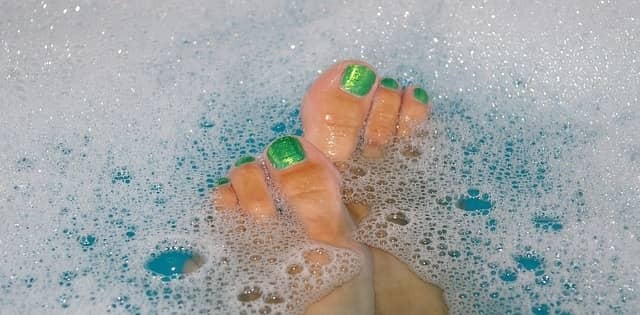
Can you soak your feet in Lysol?
This is a debatable question. There are sites and even some doctors recommending to soak your feet in Lysol. In direct contrast, responses claim it can cause more harm than good with some recalling stories of the Lysol burning their skin. Yet others have claimed using this method for years. Believe it or not, once upon a time Lysol was even pushed as safe for women’s hygiene.
According to Environmental Working Group, Lysol scores an F on their safety scale. Ethanolamine, one of Lysol’s ingredients, has moderate concern for respiratory effects and general systemic and organ effects. Mipa-borate is listed as a high concern for developmental, endocrine and reproductive effects. Finally, ammonium hydroxide
has high concern for acute aquatic toxicity and moderate concern for respiratory effects. There is additional concern to damage to vision, skin irritation, allergies, and damage.
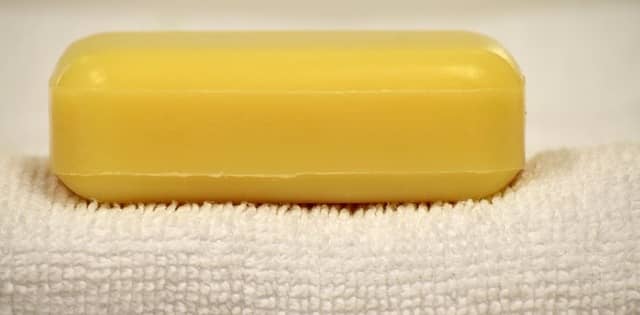
Antifungal soap for feet
There are many options for antifungal soap for feet, as well as home remedies such as essential oils. Below are listed recommendations by both feet specialists, as well as athletic facilities.
PediFix FungaSoap Liquid Tea Tree Oil: PediFix is a top seller in terms of antifungal soap. Tea tree oil, or melaleuca oil, is known to be a fungus killer. In fact, many dandruff remedies often have melaleuca or tea tree oil added to help combat the fungus causing the dandruff. This soap helps relieve the itchy and dry skin while calming the inflammation. Some reviews state that at first the fungus did not seem to recede but instant relief was felt. After some time of continued washing, the fungus did seem to go away.
Defense Soap: Just like PediFix, this soap is made with tea tree oil. It adds in eucalyptus oil and has been clinically proven to help wash away bacteria, viruses and fungus. Many contact sports teams use this soap to help combat the passing of all the nasties that come with contact sports. It claims to be natural and used with sensitive skin.
Dr. Bronner’s Magic Pure Castile Soap: This soap is a common home remedy for a variety of issues so it is no surprise to see it listed for fungal infections! It come in multiple scents and uses essential oils for an added punch. This can even be added to laundry. As stated above, tea tree oil is a common cure for fungus and Dr. Bronner’s Magic soap also has a tea tree oil version.
Power Clean Soap Organic Essential Oil Bar: This soap comes both in a bar and a castile soap. It is natural and organic and does not contain any of the harsh parabens or synthetics of many cleaners. It has a variety of types to chose from but as of yet, they have not added tea tree to the mix.
Athlete’s Soap: This liquid soap is quite thin, so expect to go through it quickly. It uses Certified Organic oils and tea tree oil. The soap claims to be free from harmful chemicals, fragrances and dyes and is paraben free.
Anti-fungal Soap: like the name says, this liquid soap is for anti-fungal purposes on feet and body. This bottle contains a powerhouse of essential oils to help clear up fungal infections. It also is synthetic free and contains no parabens.
Blue Steel Sports Soap with Eucalyptus and Tea Tree Oil: This soap can easily be picked up on Amazon. It includes the eucalyptus and tea tree oils, as well as a natural exfoliant to help scrub while your lather. Because its tripled milled, it stays compact and you can expect to use it longer than most soaps. The exfoliant helps to smooth skin and get the soap in all the groves and cracks that the feet may have.
Conclusion
Keeping your feet in dark, warm, and moist conditions is a sure way to get a nice case of foot fungus. The methods of rotating shoes, drying them out thoroughly, utilizing the sun and UV light when possible, washing in hot water reaching 140 degrees Fahrenheit and using antifungal soaps and essential oils are your best defenses against a nasty case of athlete’s foot. Remember that while sharing is caring, this adage is not applicable to foot fungus or other communicable diseases.
